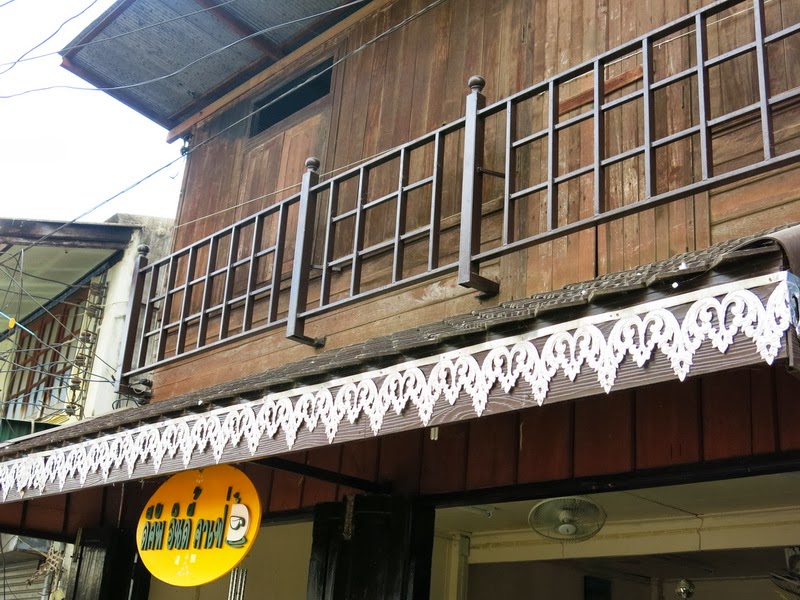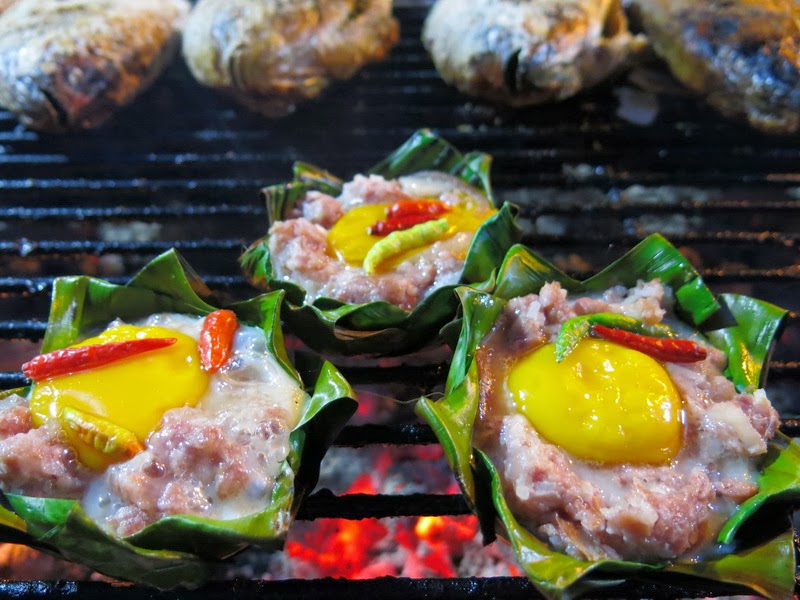 |
| Chong Kham and Chong Klang Temples |
Nestled in the rolling high
mountains of the Shan Hills in the north of
Thailand, the isolated
Mae Hong Son (MHS) valley province is a destination known for slow life paces
and ways of life that has changed only little through time. Strolling the 6 sq. km. MHS downtown offers a chance to see
cultural identities of its mixed-ethnic residents become alive through
century-old teak-wood houses, food stalls, dialectic words of items whose
official Thai language names don’t exist, ethnic costumes daily worn, and colorful
festivals. The town has seen modern infrastructure and experienced impacts of
fast growing tourism, unfortunately, the fate shared even by remote villages in
the country, but the local have preserved their cultural identities so strongly
enough visitors only find it unique and unrivaled by anywhere else.
----
The
official settlement on the plain where downtown MHS is today was first
recognized in 1831 when a king of Chiang Mai, a prominent city at the time,
ordered a village built - assigning a village leader and having him invite Tai
Yai and other hill tribal people, namely Karen, Lua, Lahu who had been living
around the plain to build cottages on it. With Tai Yai as the major population
of the village, the nowadays downtown is dominated by their culture with the
presence of other tribal identities here and there.
The rising of chic boutique hotels and coffee shops in the downtown is the result of the tourism that arrived only less than a decade ago. Nevertheless, blending the new in while preserving the old, the local have crafted a perfect picture of the town harmoniously co-existed by originality and cutting-edge facilities shelled in the original appearance, a quite rare character in northern Thailand’s tourist destinations.
To understand the cultural
background of MHS downtown and plan your sightseeing tour, visit MHS Living Museum Information
Center an old teakwood 2-storey house tugged at Singhanatbamrung street.
The center offers insightful information, colorful illustrations and pictures
of downtown building’s architecture, local food and festivals, and many more.
Pictures of the town’s older days and cute postcards adorn the walls while models
of old houses scatter the second floor with detailed explanation on the old
house renovation project. The staffs, always in Tai Yai colorful clothes, speak
great English and are very helpful. Brochures and maps are available for free
grabs to give you an orientation before setting your foot to explore the town
yourself.
 |
| MHS Living Museum Information Center |
Living It
Old House Architecture To the left
and the right of the Information Center is strips of teakwood houses aging
minimum 50 years old. Most of the houses follow Tai Yai architecture of ruen
chua diew (one roof) and ruen faed (double roof). In October, you
may see chong para, a paper model of Tai Yai temples hanging on the
second-floor balcony of these houses, signaling the end of Buddhist Lent. While
the ones on the backstreets along Singhanatbamrung remain pure residence, the
up-front ones have been turned into stores, restaurants, and coffee shops. Anyamanee,
built in 1895, now sells souvenirs, Tai Yai accessories and clothes. Hern
Yai Kaew serves coffee and fusion dishes. At Singhanatbamrung
intersection, a funky pub called Crossroad serves European dishes and is
popular among bikers.
 |
| An Old Teak-wood House Turned into A Coffee Shop |
Tai Yai Cuisine Served
with steamed rice and fresh veggies, Tai Yai dishes incorporates
lots of Thai herbs and smelly beans (fermented ground soybeans shaping
like discs) as the main ingredients. At the morning Sia Yood market,
find your breakfast stalls of tua pu aun (hot chick pea noodle soup), khao
raem fin (Tai Yai bean curd), khanom cheen nam ngiew (rice noodles with spicy pork sauce), and many
more. Then there are stand-alone restaurants with recipes passed down for
generations. At Aunt Sri Bua Tai Yai restaurant (51, Singhanatbamrung st, tel. 053 612
471), try her signatures nua dung (spicy pork balls mixed with aromatic
herbs) and kai aub (baked chicken curry). For sweet tooth, head
to Aunt Manee Tai Yai Sweets (down the alley where Aunt Sri Bua’s is),
desserts such as alawa (rice pudding with coconut milk and sugarcane, suay
tamin (steamed sticky rice with coconut milk topped with a contrasting layer of hard sugar) come in a mouthful size
banana-leaf wraps.
Ethic Costumes Apart from
the Thursday Campaign when all government officials wear traditional Tai Yai
costumes to work, the night market around the downtown Chong Kham Swamp hosts
stalls whose ethnic-race owners usually adorn themselves with the best tribal
costumes. Usually spotted are the Black Lahu with black shirts and pants of
red, blue and white stripes on the arms and legs, Hmong with colorful velvet
textile embroidered with glittering beads, among others.
 |
| A Black Lahu Lady |
Tai Yai Temples The
Tai Yai temples of Chong Kham and Chong Klang are the center of reverence and
venues for festivals year-round. Facing Chong Kham Swamp,
the left-side Chong Kham and the right-side Chong Klang share the same wall
which makes them look like one big monastery. Influenced by Burmese temple
architecture, both are famous for tiered roof adorned with plates of elaborately
carved galvanized iron coated in silver or gold color. Chong Kham, built in
1797, is MHS’s first temple and hosts a Buddha relics pagoda while Chong Klang
has a small museum in the temple’s hall exhibiting wood carvings, statues, and
paintings by Burmese artisans.
 |
| Beeswax Candles |
 |
| Roof Ornament, Carved Galvanized Iron |
 |
| A Wooden Carved Wall, Chong Klang Temple |
 |
| An Angel Statue in Chong Klang's Burmese Wooden Statue Museum |
 |
| Tiered Roof, Chong Klang Temple |
 |
| Fireworks and Lanterns, Perd Muang Tai Festival |
 |
| A Hill Tribe's House Mock-Up, Perd Muang Tai Festival |
Make it Happen!
When to Go
Best time to visit MHS is from November to February
when the weather is dry and mild, with the average temperature of 25 - 27˚C.
For trekkers, early November sees wild flower blossoms and July to September
sees rice fields turn green.
Getting There
From Chiang Mai (CM) there are two bus routes to Mae Hong
Son. The northern route through Pai (270 km) takes 6-7 hours and the southern
route via Mae Sariang takes 7-8 hours. Buses via Pai leave CM bus arcade 12
times a day from 6:30am to 4pm and the ones via Mae Sariang leave 7 times day
from 6:30am to 9pm.
Alternatively,
Nor Air flies from CM to MHS 3 times a day. Check the flight schedule at www.nokair.com.
Where to stay
MHS downtown offers plenty of mid-range
accommodation for its small size. The Residence@MHS (T:053 614 100) is
MHS’s first boutique hotel with rooms tastefully decorated with teak furniture.
Piya Guesthouse (T:053 611
260) sitting in front of Chong Kham Swamp which is considered the town center
offers very clean, heavily
furnished rooms with TVs and air-con. Ngamta Hotel (T:053 612 794) at
the junction of Khunlumpapas Road has reasonable rates and a central location,
with spotless and nicely decorated rooms that all come with air-con, hot
shower, TV and fridge.
Where to Eat
The night market stretching from the swamp to Khunlumpapas Road is a good
place to forage local Tai Yai food, grilled chicken and fish served with somtam
or spicy papaya salad. There is also a strip of bars and restaurants in front
of the swamp itself. Fern MHS Restaurant (T: 053 611374; 87, Khunlumpapas Rd.) serves
Tai Yai, Thai, and European dishes in antique house, popular among
tour groups.
 |
| Grilled Fermented Pork and Egg in Banana Wraps, Night Market |
 |
| Sesame Sticks, Traditional Tai Yai Dessert, Night Market |
 |
| A Souvenir Stall, Night Market |
Watch the story's video: http://www.youtube.com/watch?v=lthO1RV5ZGU
See more images of the story: http://www.flickr.com/photos/92886568@N08/sets/72157639961698524/
Send me comments: https://www.facebook.com/suwida.boonyatistarn.1














No comments:
Post a Comment